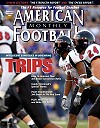AMERICAN FOOTBALL MONTHLY THE #1 RESOURCE FOR FOOTBALL COACHES
Article CategoriesAFM Magazine
|
The Strength Reportby: Chris CarlisleUSC, Strength Coach © More from this issue I’ve been in the business of coaching athletes for over 20 years. I started at the high school level, moved to the junior college level and finally into the D-I College level. Prior to my coaching career I was part of the offensive and defensive line for my entire youth / high school / college football career. So in short I’ve always been interested in how to develop explosiveness and speed in all athletes. Throughout all of these levels I have found that there are basics of instruction that have can be followed to obtain great success. You must establish a general philosophy. My philosophy is How To (Great Technique), How Fast (Movement and Progression) and How Much (Volume, Intensity and Distance). With these three simple ideas I can make....The full article can only be seen by subscribers. Subscribe today!
|
|
|||||||
| HOME |
MAGAZINE |
SUBSCRIBE | ONLINE COLUMNISTS | COACHING VIDEOS |
Copyright 2026, AmericanFootballMonthly.com
All Rights Reserved





